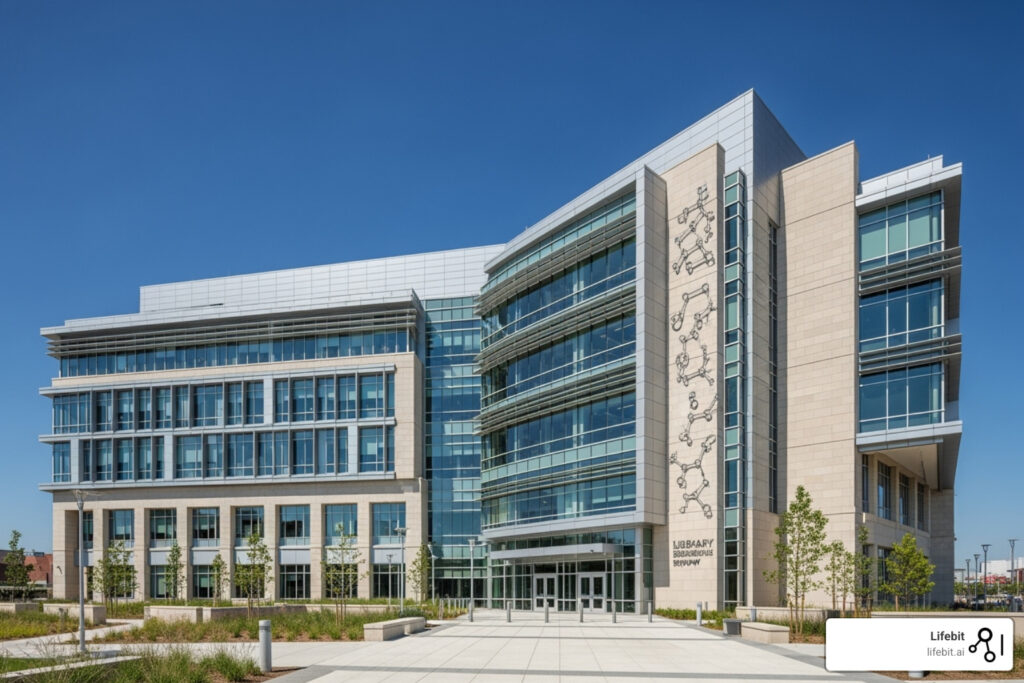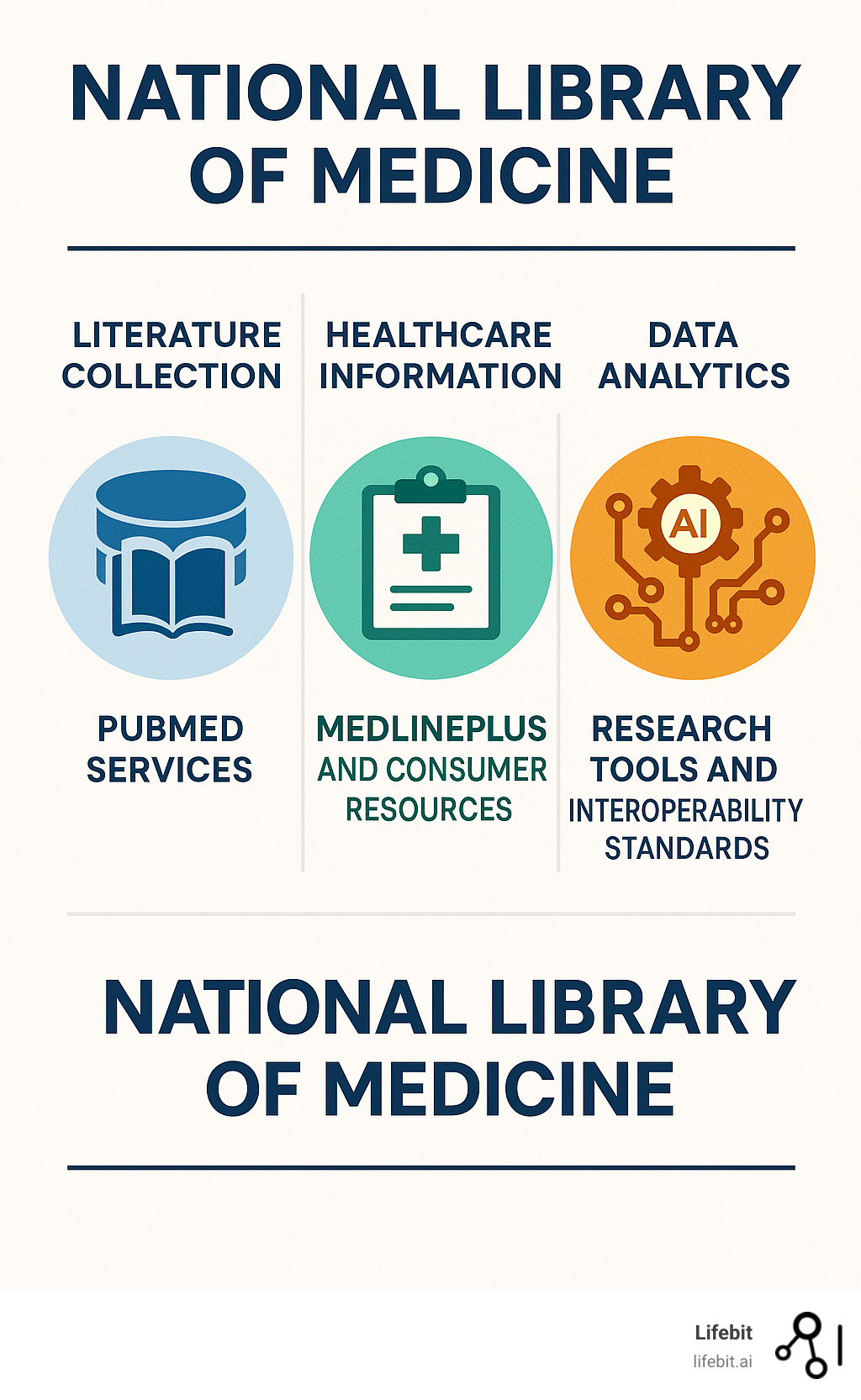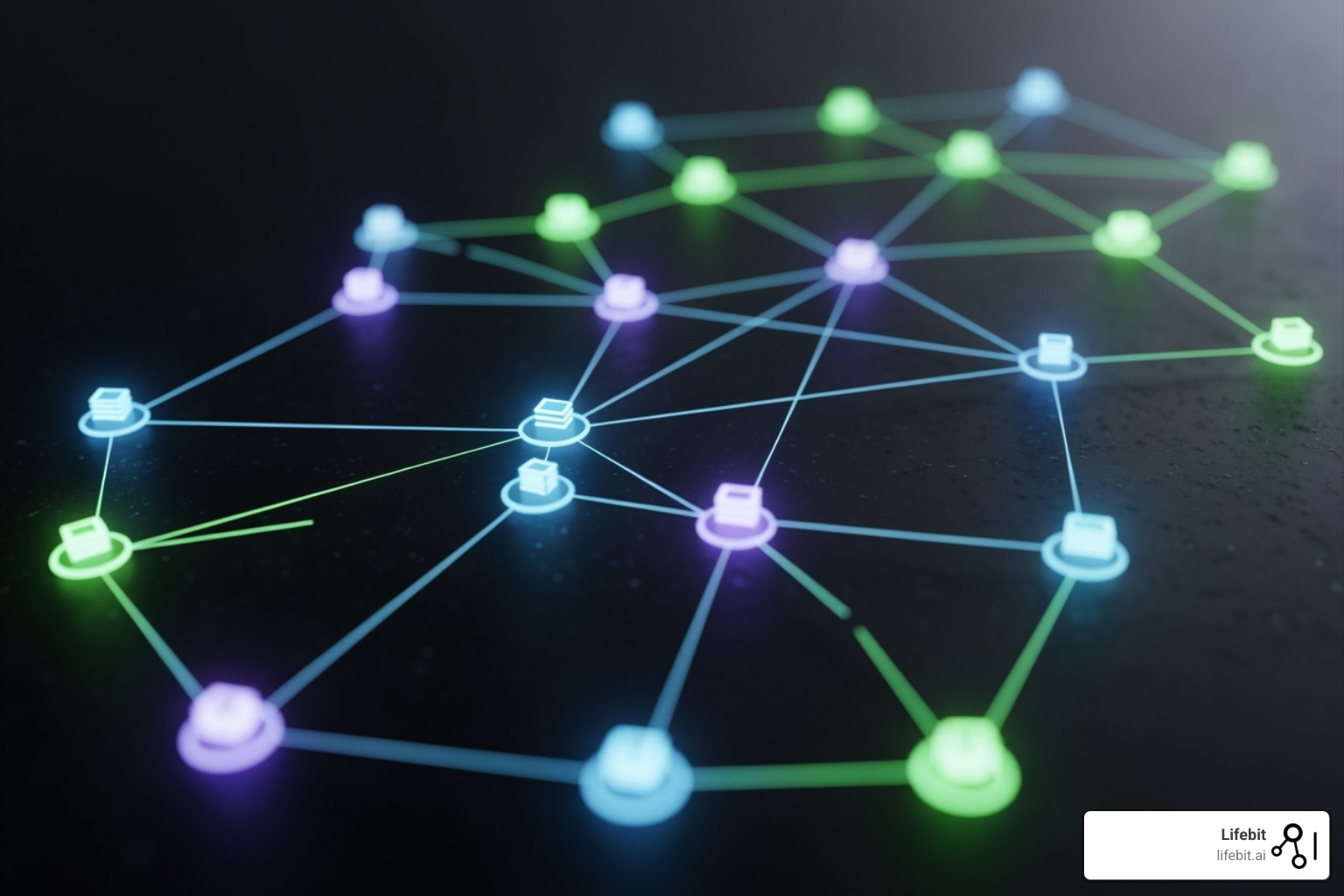Medical Research Made Easy – Exploring the National Library of Medicine

National Library of Medicine: The #1 Health Hub
Why the National Library of Medicine is Your Gateway to Medical Research
The National Library of Medicine (NLM) is the world’s largest biomedical library, a cornerstone resource for researchers, healthcare professionals, and the public. Part of the National Institutes of Health (NIH) in Bethesda, Maryland, the NLM has accelerated biomedical findy and powered data-driven health since 1836.
Quick Reference: What the National Library of Medicine Offers
- For Researchers: PubMed (35+ million citations), PubMed Central (full-text articles), MeSH controlled vocabulary
- For the Public: MedlinePlus (consumer health info), ClinicalTrials.gov (clinical study database)
- For Data Scientists: NCBI databases, GenBank, BLAST tools, UMLS terminology services
- Key Statistics: 8,100+ library network members, 200+ annual research trainees, 40+ specialized databases
The NLM’s mission extends beyond traditional library services, translating research into practice, supporting healthcare, and promoting healthy behaviors via free online access to health data. From a small collection in the Army Surgeon General’s office to one of the most visited federal government websites, the NLM has consistently pioneered new ways to make biomedical information accessible.
For organizations handling sensitive health data across federated environments, understanding the NLM’s approach to data standardization and interoperability becomes crucial for compliance and real-time analytics.
I’m Maria Chatzou Dunford, CEO and Co-founder of Lifebit. With over 15 years in computational biology and biomedical data platforms, I’ve seen how National Library of Medicine resources power global healthcare research through standardized terminologies and accessible data repositories.

National Library of Medicine terms to learn:
- Cancer Moonshot
- Defense Health Agency
What is the National Library of Medicine?
The National Library of Medicine (NLM) is the world’s largest medical library and a powerhouse for advancing global health research. As part of the National Institutes of Health (NIH) and the U.S. Department of Health and Human Services, the NLM bridges complex biomedical research with real-world health applications.
The NLM’s mission focuses on translating research into practice, supporting health care, and promoting healthy behavior. For researchers, doctors, and patients alike, the NLM provides free access to reliable medical information.
As a global hub for biomedical data, the NLM acquires, organizes, and preserves scholarly literature, making it available online. Beyond storage, it conducts research in biomedical communications, develops data-sharing technologies, and funds research in biomedical informatics and data science.
As the world’s largest medical library, the NLM serves millions daily via its digital platforms, making it one of the most visited federal government websites. This reach ensures vital health information gets to everyone, from researchers to patients.
From Humble Beginnings: Key Historical Milestones
The National Library of Medicine began in 1836 as a small collection of medical books in the U.S. Army Surgeon General’s office. This modest resource for military doctors grew into the world’s premier medical information center.
Under the leadership of visionary John Shaw Billings, the collection evolved from a military library into a national resource for the broader medical community.
The turning point came in 1956 with the National Library of Medicine Act. This legislation transformed the Armed Forces Medical Library into the National Library of Medicine under the Public Health Service, turning a military resource into a national treasure.
In 1962, the NLM moved to the NIH campus in Bethesda, Maryland, integrating it into the national health research enterprise.
A major change came in 1964 with MEDLARS (Medical Literature Analysis and Retrieval System). This groundbreaking computer-based system allowed electronic searching of biomedical literature, laying the foundation for today’s digital databases.
You can explore more details of this journey in A Brief History of NLM, which chronicles its growth into a global powerhouse.
The Leadership and Structure of the National Library of Medicine
The National Library of Medicine operates through specialized divisions, each vital for delivering medical information and advancing research. This structure ensures every part of the NLM’s mission receives expert attention.
The Extramural Programs Division extends the NLM’s impact by providing grants for biomedical informatics and data science research and funding training programs for future health data experts.
The Division of Library Operations is central to the library, handling the acquisition, organization, and preservation of biomedical literature. The team creates authoritative indexing, builds databases like MEDLINE, manages services like DOCLINE, and oversees public resources like MedlinePlus.
The National Center for Biotechnology Information (NCBI), established in 1988, is a cornerstone for molecular biology research. It maintains critical databases like GenBank and develops research tools like BLAST. For researchers using genomic data, NCBI resources are indispensable.
The Lister Hill National Center for Biomedical Communications (LHNCBC), created in 1968, drives innovation in health communications. This research powerhouse applies AI to medical imaging and develops key health data standards like HL7 FHIR for seamless information sharing.
The NLM’s leadership reflects its commitment to innovation. Patricia Flatley Brennan became the first woman and nurse to lead the library in 2016. After her 2023 retirement, Stephen Sherry became Acting Director, continuing the NLM’s visionary leadership in biomedical informatics.
This structure allows the National Library of Medicine to tackle everything from preserving historical texts to developing cutting-edge AI for modern healthcare.
A Digital Treasure Trove: NLM’s Key Online Resources
The National Library of Medicine offers free online access to nearly all its resources. This commitment has made its digital platforms some of the most visited federal government websites.
Whether you’re a researcher or a patient, the NLM has a resource for you. Its digital treasure trove supports scientific findy and empowers public health.
For Researchers: PubMed, PMC, and MeSH
PubMed is a powerhouse database for biomedical research, offering access to over 35 million citations from literature dating back to the 1950s. It’s the gateway to MEDLINE, the core database first launched online in 1971. A completely updated, more intuitive version was launched in 2020. To harness its full power, researchers can use advanced search features like Boolean operators (AND, OR, NOT) to combine concepts and field tags (e.g., [AU] for author, [TIAB] for title/abstract) to narrow results. Users can also create a free “My NCBI” account to save searches, set up email alerts for new research, and customize their experience.
PubMed Central (PMC) goes a step further, providing full-text access to millions of research papers. Launched in 2000, PMC is the go-to archive for biomedical literature. Its importance grew significantly with the NIH Public Access Policy, which since 2008 has required scientists to submit final peer-reviewed journal manuscripts that arise from NIH funds to PMC upon acceptance for publication. This ensures that the results of publicly funded research are accessible to the American public, accelerating the translation of research into knowledge and practice.
Searching millions of papers is easier with Medical Subject Headings (MeSH). This comprehensive controlled vocabulary, organized in a hierarchy, helps you search with consistent, precise terms. For example, searching for “Myocardial Infarction” will also retrieve articles indexed under more specific terms like “Myocardial Stunning” or broader terms like “Heart Diseases.” This structure guides you to the correct terminology and ensures you don’t miss relevant papers that use different phrasing for the same concept.
Beyond these, researchers can use specialized databases like TOXLINE (toxicology), DailyMed (drug labels), and HSRProj (health services research). The NLM Drug Information Portal is a one-stop shop, searching all drug-related databases at once. Through NCBI, you’ll find genetic data in Gene, Nucleotide, Protein, ClinVar, and the Sequence Read Archive.
For the Public: MedlinePlus and ClinicalTrials.gov
MedlinePlus, created in 1998, translates complex medical information into plain, understandable English. Information is organized into categories like health topics, drugs & supplements, and medical tests. It’s also available in Spanish via MedlinePlus en español.
ClinicalTrials.gov, launched in 2000, makes clinical research transparent and accessible for those interested in participating in or learning about studies. Its role was solidified by the FDA Amendments Act of 2007 (FDAAA 801), which mandates that most clinical trials register and submit summary results to the database. This requirement combats publication bias (where studies with negative results are less likely to be published) and gives researchers, doctors, and patients a more complete picture of the evidence for a particular treatment. You can search for studies by condition, location, or treatment. The platform also provides information on Expanded Access programs, which can help patients with serious conditions access experimental treatments outside of clinical trials.
For Data Scientists: Specialized Databases and Tools
For data scientists and bioinformaticians, the National Center for Biotechnology Information (NCBI) offers a computational playground with comprehensive biological databases and analysis tools.
GenBank is a massive, publicly available collection of DNA sequences. The Sequence Read Archive (SRA) stores petabytes of raw sequencing data; in 2019, SRA data was moved to the cloud, making large-scale analyses faster and more accessible.
BLAST (Basic Local Alignment Search Tool) is an indispensable algorithm for comparing biological sequences like DNA, RNA, or protein.
The NLM’s key contribution to data science is standardization. The Unified Medical Language System (UMLS) is not a single vocabulary but a set of resources that unifies dozens of health vocabularies, enabling different computer systems to “speak the same language.” Its three main components are:
- The Metathesaurus: The core of the UMLS, it organizes over 200 different source vocabularies (including RxNorm, SNOMED CT, and MeSH) into a single structure of concepts, terms, and relationships.
- The Semantic Network: This defines broad categories (e.g., “Disease or Syndrome,” “Pharmacologic Substance”) and the relationships between them (e.g., “treats”), providing a consistent categorization of all concepts in the Metathesaurus.
- The SPECIALIST Lexicon and Lexical Tools: A large English lexicon containing syntactic, morphological, and orthographic information, used by NLP systems to process biomedical text.
As the U.S. National Release Center for SNOMED CT, a comprehensive clinical terminology, the NLM helps maintain this standard, which powers electronic health records.
Powering the Future of Health: NLM’s Role in Research and Data Science
The National Library of Medicine actively shapes the future of healthcare through research in computational health informatics, data management, and data accessibility.

The NLM bridges raw data and health improvements. As biomedical information grows, the NLM works to ensure it can be used securely and efficiently, turning data into helpful insights.
Advancing Computational Health and AI in Medicine
The NLM helps lead the AI revolution in healthcare. Its Intramural Research Program pushes the boundaries of biomedical informatics, computational biology, and data science.
One exciting project is TrialGPT, an AI system that uses natural language processing (NLP) to analyze the complex eligibility criteria of clinical trials and match them against patient data from electronic health records. This has the potential to dramatically accelerate medical breakthroughs by finding qualified participants faster and more accurately than manual methods.
The Lister Hill National Center for Biomedical Communications applies AI to medical images, developing systems to identify malaria parasites in blood smears and classify chest X-rays for tuberculosis. These deep learning tools can automate tedious, time-consuming tasks for pathologists and radiologists, helping doctors make faster, more accurate diagnoses. This is particularly impactful in resource-limited areas where specialists are scarce, allowing for rapid screening of large populations.
The Medical Text Indexer uses machine learning to suggest MeSH terms for MEDLINE citations, improving the speed and consistency of indexing. This, in turn, enhances searchability for researchers and healthcare professionals who rely on PubMed daily.
An ambitious early project was the Visible Human Project. The Visible Human Male (1994) and Female (1995) datasets, consisting of thousands of cross-sectional cryosection, CT, and MRI images of two cadavers, revolutionized anatomical study. They provided the first comprehensive, high-resolution digital atlas of the human body, enabling new approaches to surgical simulation, medical education, and imaging research.
You can explore more about NLM’s data science initiatives to see how we’re continuing to push these boundaries.
Fostering Data Standards and Interoperability
Medical data is only useful if systems can communicate, which is why the NLM’s work on data standardization and interoperability is crucial. The National Library of Medicine is a global leader in creating standards for seamless health information exchange, with its Health IT Data Standards work impacting healthcare systems worldwide.
A major contribution is leading the development of HL7 FHIR (Fast Healthcare Interoperability Resources). FHIR is a next-generation standard revolutionizing how healthcare data is shared and integrated. Unlike older, more rigid standards, FHIR uses modern web technologies, including RESTful APIs and data formats like JSON and XML. It breaks down health data into modular components called “Resources” (e.g., Patient, Observation, MedicationRequest). This approach makes it far easier for developers to build applications that can retrieve and manipulate specific pieces of health information from different systems, such as pulling lab results from a hospital’s EHR directly into a patient-facing mobile app.
The NLM also manages the NIH Common Data Element (CDE) Repository, which promotes the use of standardized data collection questions and fields across NIH-funded clinical research. By encouraging researchers to use the same definitions and formats for common data points (like blood pressure or pain scores), the CDE repository makes it possible to aggregate and compare data from different studies, increasing their statistical power and scientific value.
Data curation includes managing vocabularies through the Unified Medical Language System (UMLS), which harmonizes terms like “heart attack” and “myocardial infarction” across different systems, ensuring that data remains meaningful when exchanged.
Our Strategic Plan 2017-2027 outlines our vision for becoming an even more robust platform for biomedical findy and data-powered health, ensuring information flows smoothly and securely.
Building a Data-Skilled Workforce and Fostering Collaboration
The National Library of Medicine recognizes that skilled researchers are vital for medical breakthroughs, making workforce development a core mission. It focuses on building the human capacity to use complex biomedical data effectively. The value of the world’s largest medical data collection lies in its analysis, and the NLM’s training programs, partnerships, and grant support are key to open uping it.
Training the Next Generation of Data Scientists
Each year, the NLM invests in about 200 trainees through its Biomedical Informatics Training Program. Supporting pre- and post-doctoral researchers at 16 university programs, it creates a pipeline of experts in both medicine and data science.
The training has a practical focus: trainees work with real biomedical data on genuine research challenges. Many former trainees now lead research initiatives, develop health technologies, and teach future data scientists.
Beyond formal degrees, the NLM also focuses on increasing the data science capacity of librarians. Equipping these professionals with advanced data skills creates a multiplier effect in the research community.
A Network of Knowledge: Key Partnerships
The National Library of Medicine works through a network of partnerships with academia, government, and community organizations. As part of the National Institutes of Health (NIH), the NLM collaborates with other institutes to tackle complex health challenges, ensuring its services meet the scientific community’s evolving needs.
Its most extensive partnership is the National Network of Libraries of Medicine (NNLM), connecting the NLM with over 8,100 members nationwide. Managed by the Office of Engagement and Training, this network ensures reliable health information reaches diverse populations.
The NNLM is vital for addressing health disparities, bringing trusted medical information to underserved populations through community organizations and public libraries.
Strategic partnerships with academic institutions and government agencies, like the National Science Foundation, create interdisciplinary teams to tackle complex health challenges.
Involvement in initiatives like the All of Us Research Program shows a commitment to inclusive research, helping engage underrepresented communities to ensure precision medicine benefits everyone.
These essential partnerships expand the reach of biomedical knowledge. In an era of complex global health challenges, collaboration is key to improving human health.
Frequently Asked Questions about the NLM
Navigating National Library of Medicine resources can seem overwhelming. Here are answers to common questions from new users.
How can I access the resources of the National Library of Medicine?
Most NLM resources are completely free. You can access PubMed, MedlinePlus, and ClinicalTrials.gov directly from their websites without an account or subscription fees. This reflects the NLM’s commitment to making health information available to everyone.
Some specialized services might require registration, but the vast majority of what you need is available instantly and at no cost.
Is the information on MedlinePlus reliable?
Yes. MedlinePlus is one of the most trusted online health information sources. Produced by the NLM, it meets the highest standards for accuracy and reliability. Information comes from authoritative sources and is reviewed by medical experts. A team of experts curates the information, translating complex research into easy-to-understand language while maintaining accuracy.
What is the difference between PubMed and PubMed Central (PMC)?
This common point of confusion is an important distinction.
PubMed is a massive library catalog providing citations and abstracts from biomedical literature. It offers a “preview” of research papers with details like authors and publication dates.
PubMed Central (PMC) is a free, full-text archive where you can read complete research papers, including all data, methodology, and findings.
For preliminary research, PubMed abstracts may suffice. For in-depth analysis of methodology or data, you’ll need the full articles in PMC.
Conclusion
The National Library of Medicine has transformed from a modest book collection into the world’s largest biomedical library and a powerhouse for computational health informatics. Since 1836, it has become an essential tool for researchers, healthcare professionals, and the public.
Every day, millions worldwide use free resources like PubMed, MedlinePlus, and ClinicalTrials.gov. From scientists researching cancer treatments to parents looking up a child’s condition, vital health knowledge is just a click away.
The NLM is also shaping the future. Its work in computational health and AI in medicine is building the foundation for tomorrow’s breakthroughs, from TrialGPT matching patients to trials to data standards enabling health system interoperability.
The NLM is also committed to training the next generation, supporting over 200 trainees annually through university partnerships. Its collaboration with the National Network of Libraries of Medicine and its 8,100+ members ensures high-quality health information reaches communities everywhere.
As biomedical data grows in scale and complexity, leveraging it securely and efficiently is critical. Innovative federated platforms are essential for secure research on sensitive health data while maintaining privacy and compliance.
The National Library of Medicine will continue to evolve, just as it has for nearly two centuries. Its mission remains the same: to make the world’s biomedical knowledge accessible to all, supporting better health decisions and advancing scientific findy for generations to come.



